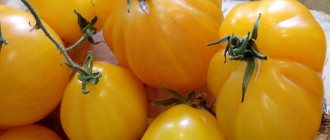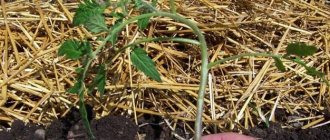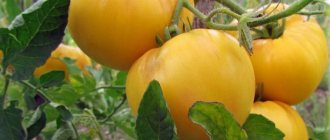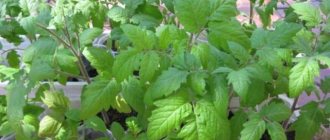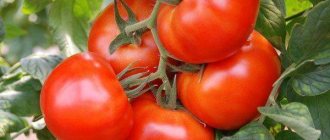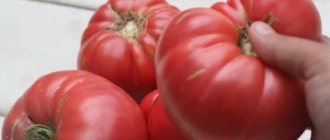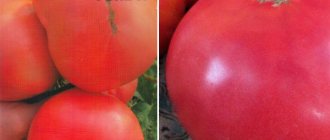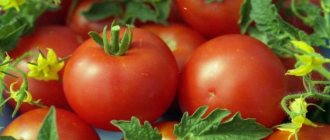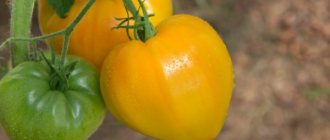Tomatoes, united by one common name - Japanese truffle, have a very interesting shape, it really resembles everyone's favorite candy with that name. In addition to the unusual shape, the creators also offer a variety of colors. Tomatoes from the Japanese Truffle series look aesthetically pleasing both on the festive table and in an ordinary vitamin salad. But this is not the only advantage of the series - almost all reviews about the taste of the fruit are very high. The seeds of these colorful tomatoes are distributed under the Biotechnika brand. The varieties are not included in the State Register of Breeding Achievements of the Russian Federation, but many tomato growers in Russia and Ukraine are well familiar with them, and not just from hearsay. All varieties are not hybrids, so you can collect seeds for further propagation yourself.
Red
It should be noted that the characteristics of all varieties are the same, as well as agricultural techniques. Therefore, we will consider what features are inherent in the culture as a whole, and then we will understand the nuances.
Description and characteristics of the variety
Japanese truffle tomatoes are characterized by a tall, continuously growing stem and therefore belong to indeterminate crops. The trunk length varies from 1.5 to 2 meters, depending on the growing conditions. To prevent the stem from breaking, fixation is required.
The bush is densely covered with dark green foliage, quickly overgrown with side branches. Excess shoots are pinched.
The Japanese truffle tomato is mid-season, the fruits ripen 110-120 days after the shoots form. Tomatoes are tied on clusters, 5-6 pieces on each.
The yield is average, you get 2-3 kg of fruit harvest per bush or 10-13 kg per square meter. If agrotechnical standards are observed and favorable growing conditions are provided, approximately 4-5 kg of yield per plant can be achieved.
If we look at the red truffle tomato in detail, the description of the variety includes information about the fruit. Tomatoes are a rich scarlet color, pear-shaped, with longitudinal convex stripes. The weight of one tomato is 150-200 grams. The skin is thick, protects the vegetable from damage during transportation, and promotes long-term storage.
If you collect the green fruits in June and place them in a cool place, the harvest will last until late autumn.
Red truffle contains juicy, fleshy pulp. Due to its pronounced sweetness, it is widely used in vegetable salads, hot dishes, and cold appetizers. Pickled tomatoes also give excellent taste.
The shape of the fruit is similar to the Matryoshka tomato. The latter refers to mid-season determinate varieties.
Description of tomato Truffle
Among the considerable number of tomato varieties, the popularity of which is growing more and more every year, the Truffle tomato occupies a very prominent place. This applies to all its varieties, which differ from each other in color and some other specific features. First of all, this thesis is relevant for Japanese truffles, presented in five different colors, the seeds of which are offered by leading agricultural firms in the CIS - Biotekhnika, Siberian Garden and many others. Possessing a number of undeniable advantages, such tomatoes rightfully deserve a separate description, and therefore they are certainly worth considering in more detail.
Description of tomato Truffle
Other varieties of the variety
It is the red truffle that is most in demand among gardeners. Optimal yield indicators, high-quality fruits and cultivation characteristics make it popular in subsistence farming.
In addition to the red tomato, there are other varieties, but the main characteristics and description of the Japanese truffle variety remain the same. The color and taste of the fruits are subject to changes, and each type also has a number of distinctive features.
Cultivar varieties:
- Black truffle tomato. Unusual tomatoes, the color is dark red or brown, gradually turning into black. The density of the pulp is medium, the taste is pleasant, moderately sweet. Used in preparing various dishes, marinating. The productivity of this type is slightly higher than other types, however, seed germination is low, about 60%. Short-term storage is typical.
- Truffle pink. Tomatoes are red-pink in color. The taste is less intense compared to other types, but sweetness is felt. Productivity is average. The fruits are large, can reach up to 200 grams, and contain many grains. After irrigation, ripe vegetables are prone to cracking. Suitable for cutting vegetables and preserving.
- Golden truffle. Yellow with a golden tint, belongs to high-yielding varieties. The pulp is dense, sugary, reminiscent of fruit. The weight of the tomato does not exceed 150 grams. Keeps well at room temperature. Due to its sweetness and fruity notes, it is preferable to use fresh.
- Truffle orange. Found in bright yellow and orange tones, it produces medium yields. When tasting, a pronounced sourness is felt, although sugar content is also present. Tomato needs warmth and light, so it is preferable to cultivate it in a greenhouse. Looks beautiful when preserved.
Productivity
The hybrid has good yield. Up to 5 kg of fruits are harvested from one bush in the garden, and up to 7 kg of fruits in the greenhouse. To extend the shelf life of fresh tomatoes, you should pick them slightly unripe - they will successfully reach the condition in room conditions.
Which regions are best to grow in?
“Japanese pink truffle” is a heat-loving hybrid. The maximum yield is observed in the southern regions with long hot summers and the absence of night frosts. In the middle zone, this tomato is grown only under film covers.
Features of cultivation and care
Red truffle tomatoes are grown using seedlings. Seeds are sown in open areas in late March; for closed structures they are sown in early April. The sprouts appear in the garden bed in May.
After moving the bushes to a permanent place of growth, the Japanese red truffle tomato variety requires certain care:
- Formation. The Japanese truffle needs shaping, because the yield and quality of the fruit depend on it. If the variety is grown in a warm area or in greenhouses, it is optimal to grow the trunk into two or three stems. When growing red tomatoes in the northern regions, only one stem is left.
- Stepsonning . For better development and quality of tomatoes, remove all unnecessary branches. The procedure must be carried out throughout the entire period of growth and fruiting, otherwise the productivity of the plant will decrease.
- Garter. Since the red Japanese truffle has unlimited growth, fixation to a support is necessary. The garter is performed as the stem is pulled out. Brushes that can break under the weight of tomatoes are also fastened.
- Watering. Moderate, water strictly at the root no more than twice a week. It is carried out mainly in the evening, using settled water. After irrigation, the soil is loosened and weeds are removed. To avoid high humidity in the greenhouse, mulching is used and closed structures are ventilated.
- Feeding. You need to fertilize three times a season: during flowering, the appearance of ovaries and fruiting. Use complex mineral fertilizers or organic matter. Bird droppings and mullein infusion work well. When tomatoes begin to ripen, potassium is added to stimulate this process.
Harvest and storage
It takes approximately 115–120 days from planting to harvest. Tomatoes are picked from the bush as the fruits ripen.
Storage after harvest is long, since tomatoes have a fairly strong peel. In addition, after being picked from the bush, the tomato can ripen a little more, gradually acquiring juiciness and a sweetish taste.
So, “Japanese Truffle” is a one-of-a-kind tomato variety. Its resistance to many diseases, spectacular appearance and piquant, pronounced taste will appeal to any gardener. By growing these tomatoes in the garden or in a greenhouse, you will get unique-tasting vegetables for various culinary purposes.
Diseases and pests
Red Japanese truffle is characterized by high resistance to negative environmental factors. Thanks to this property, tomato rarely encounters nightshade pathologies.
Diseases usually affect greenhouse plants, as there is increased humidity in closed structures. In particular, brown rot is possible. If infection occurs, the affected fruits are removed and the bush is treated with the fungicide "Hom". Dry spotting also occurs. The fungicide Antrakol will help get rid of the disease.
To avoid encountering the described pathologies, it is necessary to avoid excessive watering and regularly ventilate the greenhouse.
The Red Truffle tomato is attacked by insect pests. Thrips and melon aphids often settle on the plant. To destroy parasites, the bushes are sprayed with the Zubr insecticide. Treat once three weeks before fruit ripening.
When attacked by spider mites, the drug "Karbofos" is effective. Since the described agent is of contact action, only the affected areas of the plant are treated.
Tomato Truffle red: reviews + photos
Often, gardeners from a wide variety of varieties are looking for something new and interesting for themselves, in terms of taste, shape, and color. Their needs can be fully satisfied by one very interesting variety of tomatoes: “Truffle”. It has a bright, special taste, a variety of colors and an amazing shape of vegetables. We will offer our readers a detailed description and characteristics of the “Truffle Red” tomato variety, as well as photos of vegetables of different colors of this type of tomato later in the article. Surely the information provided will be of interest to all agricultural innovators.
Advantages and disadvantages
The red Japanese tomato is characterized by a number of advantages. The advantages of this exotic variety include:
- interesting appearance of the fruit;
- excellent taste properties;
- simple agricultural technology;
- diversity of species in the variety in question;
- natural resistance to fungal pathologies;
- versatility in use;
- long storage;
- Suitable for cultivation in all regions.
In addition to the positive aspects of the red tomato, the plant also has minor disadvantages:
- the yield is fixed, it is impossible to exceed the norm;
- Regular gartering and pinching is required.
Agricultural technology
If varieties are to be grown in open ground, then the seeds are sown in March, so that by the time of planting the seedlings are 60-65 days old. If you are preparing to cultivate plants indoors, then you need to sow seeds in February. The seeds are small, so you should not bury them more than 2 cm. Picking is carried out in the phase of 2 true leaves. Hardening is carried out 1.5 - 2 weeks before planting, gradually accustoming the seedlings to new conditions. The recommended planting density for tomatoes is 4 plants per 1 square meter. Some time after planting, they are tied onto trellises. In order for the variety to show the best results, the bush is formed into 2 or 3 stems. The remaining stepsons are pruned. It is also advisable to tie up the fruit clusters of the Japanese truffle, as there is a problem with creases.
The care is standard for the culture as a whole. When ripening, a problem may arise in the form of green hangers. To avoid it, the bushes are fed with potassium fertilizers. But not only they should be in the plant’s diet. In order for the crop to develop at a good pace and for the formed fruit clusters to ripen, it is necessary to use complex universal fertilizers. Try not to over-moisten the soil, especially in a greenhouse, otherwise the skin of the fruit will begin to crack, and they may also be affected by blossom end rot.
Now let’s look at each variety of Japanese truffle separately.
- The red-fruited variety is considered the best for canning and processing. It has a wonderful taste, combining sweetness with slight sourness and a pleasant tomato aroma. Even a ripe fruit often has greenish or yellow spots near the stalk. This tomato is highly resistant to late blight.
- The Japanese golden truffle is extremely beautiful. The taste is sweet, the aroma is delicate, tomato-fruity. The transportability of the fruit is good. Many gardeners value this variety for its good shelf life, however, to do this, the tomatoes need to be picked at the stage of blanc ripeness.
- The chokeberry tomato is colored red-brown-black. The taste is good, sweetish, the flesh is dense, not watery. This variety can also suffer from green hangers, which may not disappear even after ripening.
- The orange truffle has a very beautiful fruit appearance and a rich orange color. But many people call its taste bland.
- Pink is also attractive in appearance; at the stage of consumer ripeness it becomes deep pink. But there is still controversy about the taste. Some people find it a bit bland, others really like it.
Japanese truffles are a successful series of colorful varieties that look great as a colorful mixture in a jar or in a salad. They are quite unpretentious in care, especially since agricultural technology is standard for all varieties. Taste qualities directly depend on the climate, and therefore on the cultivation skills. By following the rules of care, you can avoid problems such as burst skin and diseases. Many who have tried to grow these bright tomatoes are not going to give them up in the future. There is one drawback for all - the need for gartering and shaping.
Possible problems during cultivation
The undoubted advantage of this tomato variety is its resistance to many diseases. The “Japanese truffle” variety is not susceptible to late blight, which is a problem with many varieties of tomatoes.
However, truffle tomatoes are vulnerable to Phoma (also known as White Rot). When infected, dark spots appear on the fruits; in this case, it is necessary to immediately remove the affected parts and disinfect the entire greenhouse.
Pink giant tomato - 115 photos, description and characteristics of the variety. Planting rules and variety yield
Tomato Andromeda - description of the variety and its characteristics. Varieties of tomato and tips for choosing planting material (90 photos)
How to fertilize tomatoes when planting: choosing fertilizers and applying fertilizer to the hole. Tips for planting tomatoes (85 photos + video)
In order to avoid this disease, it is necessary to ensure that the soil is not overly soggy and use nitrogen fertilizers sparingly.
What subspecies of this variety exist?
Red truffle tomato. One of the most common subspecies, it has a slightly sweet taste. It is used not only for preservation, but also for preparing salads, marinades and soups.
Black truffle tomato. The most popular subspecies due to its unusual color and pleasant sweetish taste. In addition to preservation, it is often used in the preparation of salads.
Yellow truffle tomato. It has a golden or orange color, due to which it is often used to decorate dishes.
Pink truffle tomato. Very reminiscent of a red truffle tomato, but has a lighter pinkish color.
Key Features
First of all, it should be noted that the type of tomato in question did not get its name by chance. This is explained by the fact that the fruits of such plants have a shape that looks like a truffle, a mushroom that is one of the most popular delicacies in the world. It is also worth adding that these very original berries remind many of a pear or a light bulb. The fact that the truffle tomato owes its appearance to breeders from Russia, who managed to isolate it as a separate variety a decade and a half ago, deserves special attention.
As for other characteristics characteristic of this remarkable variety of tomatoes, their list is as follows:
- the average duration of fruit ripening of such plants is 115/- 5 days;
- truffle tomato bushes have a fairly large height, the maximum values of which can approach the 2-meter mark in greenhouse conditions (when grown in open ground, this figure is about a quarter lower);
- the number of brushes on one stem can reach up to 5 pieces, each of which grows about 5-6 berries;
- in addition to the pear shape, Truffle tomatoes have slight ribbing, which can be seen in numerous photos of these fruits presented on the World Wide Web;
- the mass of ripened berries of the plants in question is in the range of 90-170 g, relatively rarely exceeding the indicated values;
- The average yield of Truffle tomatoes in most cases is 4 kg per bush, although with proper care this figure can be noticeably higher.
Read also: Purple pepper Chocolate Joe - a gardener's dream or fun
In addition, it is reasonable to note that such tomatoes are well suited for both fresh consumption and canning. This is confirmed by a considerable number of reviews of the relevant content left by gardeners from Russia and neighboring countries.
